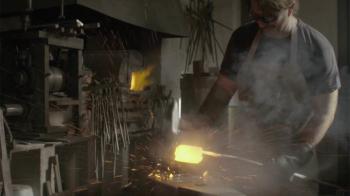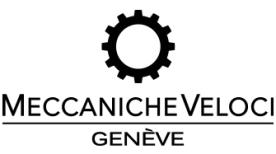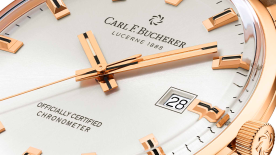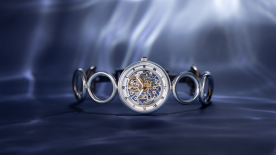At its best, modern mechanical horology is a balance of centuries-old skills with cutting-edge technology. Traditional mechanisms can be paired with exciting new materials and manufacturing techniques, allowing us to push the boundaries of what we previously thought was possible in watchmaking.
The watches of Meccaniche Veloci pursue this elusive balance, augmenting the conventional horological array of wheels and levers with a daring multi-time display and 21st-century industrial manufacture processes — not to mention a turbo-charged, motoring-inspired design.
![]()
The two headlights of the Meccaniche Veloci collection are the Icon and QuattroValvole timepieces, both boldly oversized with a drum-shaped case 49mm in diameter. Whereas the Icon has four separate sapphire crystal panes for each of its four subdials, the QuattroValvole features a full sapphire crystal glass over the upper surface of the watch.
Both Icon and QuattroValvole are equipped with the automatic calibre MV8802, developed and produced in La Chaux-de-Fonds exclusively for Meccaniche Veloci. The city of La Chaux-de-Fonds is widely acknowledged as one of the birthplaces of Swiss watchmaking, and has been designated a UNESCO World Heritage Site for the role it played in creating the global reputation of Swiss horology as we know it today.
An Icon of power
The legendary material known as Damascus steel dates back through millennia, with historical records and archaeological evidence indicating that Damascus steel was first made in the Indian subcontinent over two thousand years ago. Damascus steel was famed for its extraordinary toughness and flexibility, and its unparalleled ability to hold an edge. In addition, its beautifully grained appearance made it the perfect material for ceremonial use, and not just practical weaponry. Over the centuries, Damascus steel gained an almost mythical stature. In the 18th century, due to the changing nature of warfare and the extreme secrecy surrounding this prestigious metallurgical skill, the ability and knowledge to forge Damascus steel was lost.
![]()
Attempts to rediscover or reverse-engineer the process of creating Damascus steel were unsuccessful until the early 2000s, when sophisticated electron microscopy revealed that the dark bands of metal in Damascus steel were caused by the presence of carbon nanotubes and metallic carbides (or what we would classify as high-tech ceramics). Nanotubes, carbides, ceramics — these are terms we associate with modern materials research and innovation, but they are also accurate descriptions of forged metal objects from the first millennium.
Like apex-level modern horology, it seems that Damascus steel is the perfect balance of ancient skills with cutting-edge tech. The Meccaniche Veloci Icon Damascus takes this legendary material to house the MV8802, allowing the mesmerising waves of this pattern-welded steel to take centre stage.
![]()
Damascus steel is inextricably bound to the concepts of high performance and precision — ancient Damascus steel blades were said to be so strong and sharp that they could cleave rocks in half and slice a falling silk scarf with equal ease. By pairing this case material with the Icon timepiece, Meccaniche Veloci reaffirm their brand philosophy of power, refinement and technology.





